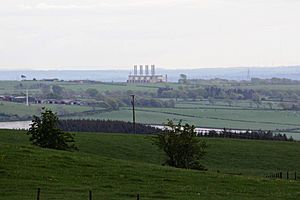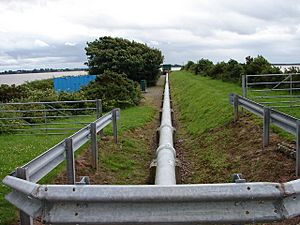Chapelcross nuclear power station facts for kids
Quick facts for kids Chapelcross Nuclear Power Station |
|
|---|---|

Chapelcross nuclear power station, prior to demolition of the cooling towers
|
|
| Country | Scotland |
| Coordinates | 55°00′57″N 3°13′34″W / 55.0157°N 3.2261°W |
| Status | Decommissioning in progress |
| Construction began | 1955 |
| Commission date | 1959 |
| Decommission date | 2004 |
| Owner(s) | Nuclear Decommissioning Authority |
| Operator(s) | Magnox Ltd |
| grid reference NY217697 | |
The Chapelcross nuclear power station was a special kind of power plant called a Magnox nuclear power station. It is now being taken apart, a process called decommissioning. This station is located near Annan in southwest Scotland. It operated from 1959 until 2004.
Chapelcross was like a twin to the Calder Hall nuclear power station in England. Both plants were first built and run by the United Kingdom Atomic Energy Authority. Their main job was to make a material called plutonium for the UK's nuclear defense program. But they also made electricity for the country's power grid. Later, as the Cold War ended and the need for nuclear weapons slowed down, making electricity became their most important job.
Today, the site is being taken apart by a company called Magnox Ltd, which is part of the Nuclear Decommissioning Authority. The station's four tall cooling towers were taken down in 2007. The reactors no longer have fuel in them. Workers are now taking apart the main parts that moved heat and gas. After this, the reactors will be left alone for a long time. This lets radiation levels drop before the reactors themselves are finally taken down.
Contents
Where is Chapelcross Located?
Chapelcross is built on a large piece of land, about 92 hectares (which is like 227 acres). This land used to be an airfield during World War II called RAF Annan. The site is about 3 kilometers (2 miles) northeast of the town of Annan in Scotland. The closest small village is Creca.
History of Chapelcross
Chapelcross was built as a "sister" plant to Calder Hall in England. Construction finished in 1959. Its main goal was to produce plutonium for the UK's nuclear defense program. Making electricity was a secondary benefit. Chapelcross and Calder Hall were the only nuclear power stations in the UK that used cooling towers to get rid of heat, instead of using sea water.
The Chapelcross Works officially opened on May 2, 1959. It was first owned by the United Kingdom Atomic Energy Authority (UKAEA). Later, in 1971, it became part of British Nuclear Fuels Limited (BNFL). The site worked with Calder Hall under BNFL until 2005.
Chapelcross had four Magnox reactors. Each reactor could make 60 MWe of electricity. The reactors were supplied by the UKAEA, and the machines that made electricity (turbines) were from C.A. Parsons & Company.
In 2005, ownership of the site moved to the Nuclear Decommissioning Authority (NDA). This is a new group that manages nuclear sites. The site is now run by Magnox Ltd, which is owned by the NDA.
In 2004, Chapelcross stopped making electricity.
Taking Down the Cooling Towers
The process of taking down Chapelcross began in 2005. The first big step was on May 20, 2007. On that day, the four tall, concrete cooling towers were carefully brought down. These towers looked like the ones at other big power stations. Explosives were used to remove a part of the towers' bases. This made the 300-foot (91-meter) tall towers fall in less than 10 seconds. They turned into about 25,000 tons of rubble. The cooling towers at Calder Hall were also taken down later that year.
Some people who lived nearby, including workers, were sad to see the towers go. They were a well-known landmark that could be seen from far away.
By December 2012, three of the four reactors had their fuel removed. All fuel was removed by February 2013.
Most of the buildings are expected to be removed by 2023–2024. After that, the site will be in a "care and maintenance" phase until 2089. The final demolition of the reactor buildings and cleaning up the site is planned for 2089 to 2095.
How the Plant Was Designed
The design of Chapelcross was very similar to Calder Hall. It had four nuclear reactors. These reactors used nuclear graphite to slow down tiny particles and carbon dioxide gas to cool them. They were powered by natural uranium fuel. The main difference was how the buildings were arranged. Chapelcross was designed with all four reactors together from the start, making its layout more compact.
The first reactor had a slightly different design. Reactors 2, 3, and 4 had special graphite parts to help them run hotter. Two of the reactors were also used to make tritium. Tritium is a special material used for the UK's nuclear defense. To make tritium, these reactors used a slightly different type of uranium fuel.
Layout and Facilities
The southern part of the site has an office building, the four reactor buildings, the turbine hall (where electricity was made), workshops, and storage areas. It also has a building for cooling used fuel and a plant that processed tritium. The northern part of the site has older buildings, including old aircraft hangars. It also used to store many drums of a yellow powder called depleted uranium. This powder was later moved from Chapelcross to another site for long-term storage.
Liquid waste from the plant was sent through a 5-kilometer (3-mile) long pipeline into the Solway Firth. All releases into the environment were carefully checked by the Scottish Environment Protection Agency (SEPA).
Chapelcross helped make tritium for the UK's nuclear defense systems, like Polaris and Trident, from about 1980 to 2005. This was done by hitting a material called lithium with tiny particles inside the reactors. The tritium gas was then taken out at the Chapelcross Processing Plant. This facility was managed by BNFL for the Ministry of Defence. The tritium was then moved to another special facility. Because it was involved in the nuclear defense program, the site was not fully checked by international groups until 1998.
Operating Experiences and Safety Events
Chapelcross had a long history of operation. Like any large industrial site, it experienced some events and challenges. Safety was always a top priority, and each event was carefully investigated to learn from it.
Fuel Problem in 1967
In May 1967, a small problem happened in Reactor 2. Some fuel got too hot because of a blockage. This caused a small amount of contamination inside the reactor. The reactor was cleaned up and started working again in 1969. It was the last reactor to stop operating in 2004.
Boiler Shell Issue in 1997
In June 1997, during a routine check, small cracks were found in one of the heat exchangers (like a boiler) in Reactor 2. Experts looked closely at the cracks. They found that the cracks had been there since the heat exchanger was built. There was no sign that the cracks had grown while the plant was running. The safety authorities decided that the material was safe.
Worker Exposure in 2001
In early 2001, during a process to remove fuel from Reactor 2, a fuel element got stuck. When workers tried to free it, the fuel element briefly came out of its protective shield. This caused the workers nearby to be exposed to a small amount of radiation. The workers reacted quickly, and the amount of radiation they received was very low. This event led to improvements in the safety of the fuel removal equipment. This incident was classified as a minor event on the International Nuclear Event Scale (INES).
Yellow Powder Leak in 2001
In July 2001, a small amount of a yellow powder called "Magnox depleted uranium" leaked from some old metal drums. This happened because rainwater got into the drums and caused them to rust. This yellow powder is less radioactive than natural uranium, but it can be harmful if swallowed, similar to lead. It doesn't spread far and is easy to clean up. The building where it was stored was improved, and the drums were put into new, stronger containers and moved to another site for safe storage.
Dropped Fuel Basket in 2001
Also in July 2001, during routine fuel removal from Reactor 3, a basket holding 24 used fuel elements fell a few feet. Remote cameras showed that some of the elements fell further down into a water-filled container at the bottom. Even though no radiation was released, dropping fuel elements is a serious matter. An investigation was started to understand what happened and prevent it from happening again.
Reactor Part Movement in 2001
In September 2001, it was found that some steel parts on top of Reactor 1's core had moved slightly. This was due to changes in the nuclear graphite inside the reactor over time. Because of this, Reactor 1 did not start up again after its annual maintenance in August 2001. Reactor 4 also had a similar issue, and even after repairs, it did not return to power.
Interim Storage Facility
A new building for storing intermediate-level radioactive waste from Chapelcross started operating in 2021. Construction began in 2014. This building is 57 by 23 meters (about 187 by 75 feet) and can hold 700 waste packages. It is designed to store this waste safely for 120 years.
See also
- Nuclear weapons and the United Kingdom
- Nuclear power in Scotland
- Nuclear power in the United Kingdom
- Energy policy of the United Kingdom
- Energy use and conservation in the United Kingdom




